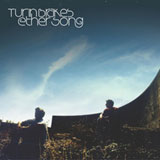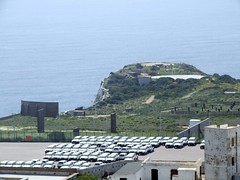by Joe Banks & Caroline Grigson
The following text was written in 1997, but did not appear in print until it featured under the title “Antiphony Architectural Supplement” on pages 57-64 of issue 6 of Sound Projector – an experimental noise magazine published in 1999 (Sound Projector is still going strong, but issue 6 is no longer available). The “Antiphony Architectural Supplement” was published to document and explore ideas suggested by the imagery of the Disinformation “Antiphony” double CD and “Antiphony Video Supplement” (later retitled “Blackout”) – both created in 1997, which featured images by photographer Julian Hills and film-maker Barry Hale of air defence Sound Mirrors found at various sites on the UK coast.
….
The solution was provided by an article by W. Harms in Shortwave Magazine, which described a series of massive concrete monoliths which still stand, slowly crumbling into waste-land at a site near Dungeness in Kent. These structures, built in the 1920s and 1930s, formed a primitive experimental early-warning system – several elegant, but extremely austere concave shapes designed to allow the precise triangulation of directional-fixes on the distant sounds of incoming enemy Zeppelins, aircraft and ships.
These shapes rise up out of the Kentish shingle like the strange ceremonial relics of a dead civilisation or unknown tribal culture (and if you consider military R&D as an anthropological entity as well as a purely technical enterprise, then perhaps this interpretation is not as wild as it seems). Appearing alongside a picture of the abandoned Church of St. Giles in the village of Imber (the ghost-town on the tank-ranges of Salisbury Plain) and digital artwork representing the anthropomorphic slang of the RAF, the sound mirrors provided photographer Julian Hills with his Disinformation ‘remix’ for “Antiphony”.
Extensive literature and archive research has so far uncovered a total of seventeen mirrors, sixteen on the Kent and Yorkshire coasts, and one at a site in Malta (which, according to Casemate magazine, is “approached through a slurry of cow muck and dead chickens”). Ten of these can still be visited today, one is buried, two have collapsed, while there are four more mirrors whose status remains, from my point of view, unknown. Architecturally many of the sound mirrors look as though they could have been designed yesterday, and it is on close inspection that they their true state of distress is revealed. It is hard not be impressed by this geometry – the striking contrasts between elegant, concave parabolas and their rough textures, their impressive solidity and substantial physical forms.
More at /seconds







